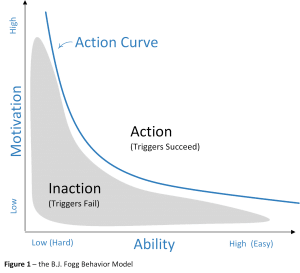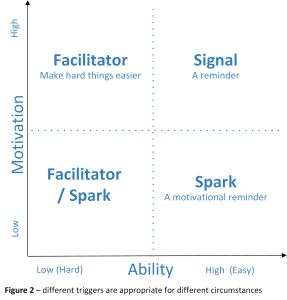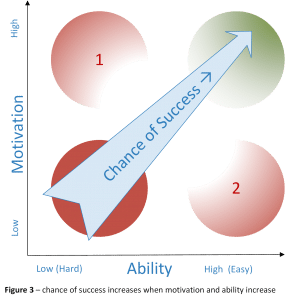How to Use BJ Fogg and the Behavioral Model for ERP Implementation Success
B.J. Fogg, Ph.D. is a famed behavior scientist at Stanford and has been described by Fortune magazine as “… one of the most sought-after thinkers in Silicon Valley.” In 2009 he published “A Behavior Model for Persuasive Design.” The ideas in the Fogg Behavior Model have lead to successful products like Facebook, Google, and Uber, and if you are not familiar with the model it is well worth a few minutes of your time.
The model says a lot about a lot, it is easy to understand and the truth of it is easy to grasp. Fogg’s model can be understood in less than a minute, yet it provides the key to unlock an understanding of why some ERP projects fail while others succeed.
 The Model in a Minute
The Model in a Minute
Fogg’s model says that behavior is a product of a trigger, motivation, and ability.
• Trigger – a prompt, an event that causes a behavior.
• Motivation – the desire to do something.
• Ability – the means to do something.
High motivation will result in action even if ability is relatively low (but not zero) and actions that are easy can occur even if motivation is relatively low (by not zero). The model provides a framework to understand the idiom “willing and able.”
Three More Minutes
Fogg goes into more detail about motivation, ability, and triggers, and the details lead to actions for success.
Motivation
Three Types of Motivation
He describes three types of motivators, each with a positive and a negative side.
Positive Negative
- Sensation (feeling) + Pleasure - Pain
- Anticipation (expectation) + Hope - Fear
- Belonging (acceptance) + Acceptance - Rejection
Leadership can drive motivation, but motivational tools are not something to be trifled with. Creating unrealistic expectations will backfire, creating undo pain, fear, or rejection will do individual and cultural damage. But it is important to acknowledge that motivation is a critical component of change, and there are ways to mitigate the risks getting it wrong.
Motivation Changes Over Time
In other work, Fogg explains that motivation changes over time, and is highest at the start of something, an example of what he calls a “Motivation Wave.” He points out that the best time to do hard things is at the beginning, consistent with the Kubler-Ross Change Curve.
Ability
When Fogg talks about ability, he uses the word ability interchangeably with simplicity. This is particularly important in software implementations – it is always good to make complicated things as simple as possible.
Six Factors that Restrict Ability – Three that Matter for Software Implementations
Fogg explains that time, money, physical effort, brain cycles, social deviance, or non-routine behaviors can all be factors that restrict ability. Three of these: time, brain cycles, and non-routine behaviors seem likely to restrict change in software implementations.
- Lack of Time – the new behavior requires additional time when time is a scare commodity,
- High “Brain Cycles” Required – the new behavior requires mental focus that might be a challenging for an already over-loaded user,
- Non-Routine Behaviors – the new behavior requires a change from well established routines, or cannot be established as routine.
Three Ways to Increase Ability
- Training – increasing skills to make things that are hard easier,
- Tools – new or better tools to make hard things easier, and
- Scaling Back – reducing the time and effort required by the behavior.
 Three Types of Triggers
Three Types of Triggers
A trigger is a prompt or a call to action, and Fogg describes three different types that are appropriate for different situations.
- Facilitator – when motivation is high but ability is low, facilitating prompts make things easier. For example, a facilitating prompt might provide an explanation of how to do something. “Use this trick to make bank reconciliations easier.”
- Signal – when motivation and ability are high, a signal is a simple reminder. “Time to reconcile bank statements.”
- Spark – when ability is high but motivation is low, sparks provide additional motivation. “Spending ten minutes reconciling banks statements now can save hours at the end of the month.”
Making the Fogg Behavior Model Work
There are obvious and subtle conclusions to make from the Fogg model.
- High motivation and high ability lead to success
- High motivation is better than low
- High ability (simplicity) is better than low
- Using motivational levers when the real issue is ability (area 1 at right) will not be effective.
- Addressing ability when the issue is motivation (area 2) will not be effective.
Know Where You Are and Take Action from There
There are books about driving motivation and books about training, job analysis and software usability. I will not get into all of the elements of ‘how’ to address issues here.
But there are some questions to ask to help diagnose those issues and the answers lead to actions.
1. Is there enough motivation?
- Is it clearly supported by leadership?
- Do people have a shared vision of why the software is being implanted and what it can mean for the organization?
- Are people rewarded for the desired behavior?
- Where are you in the implementation process – riding the initial “Motivation Wave”, or in the Kubler-Ross “Trough of Disillusionment”?
2. Do they have the ability to do what they are being asked to do?
- Is the training adequate?
- Is it too complicated or confusing?
- Too time-consuming?
- Have we added responsibilities to a role without taking any away?
- Is it too different from established routines?
3. Are prompts (triggers) provided to encourage the desired change?
- Are the right prompts used for the right circumstances? (Spark vs Facilitator?)
The answers to these questions should fill in some of the blanks in the ‘why’ and ‘what’ questions to enable successful implementations or put a challenged effort back on track.
Under the terms of this license, you are authorized to share and redistribute the content across various mediums, subject to adherence to the specified conditions: you must provide proper attribution to Stoneridge as the original creator in a manner that does not imply their endorsement of your use, the material is to be utilized solely for non-commercial purposes, and alterations, modifications, or derivative works based on the original material are strictly prohibited.
Responsibility rests with the licensee to ensure that their use of the material does not violate any other rights.



